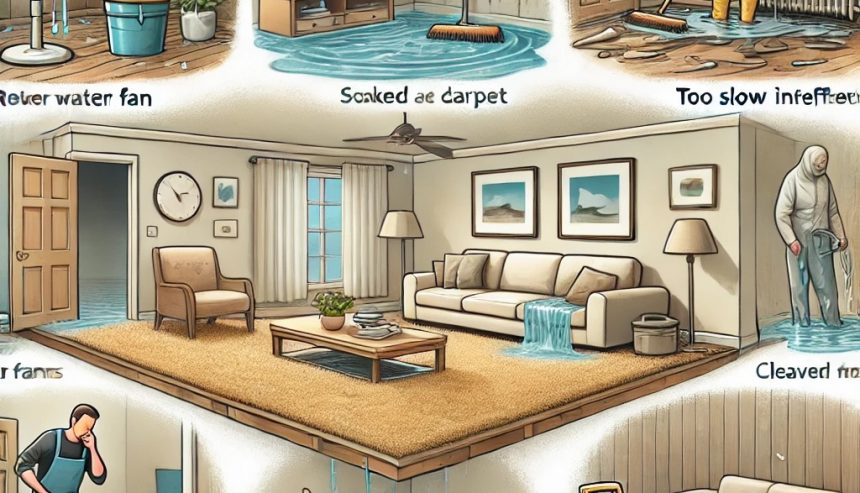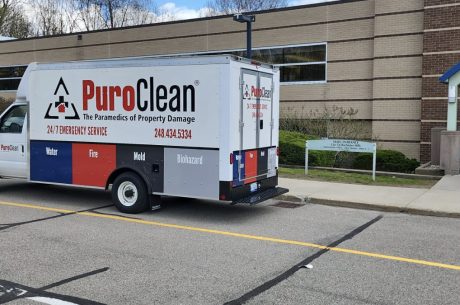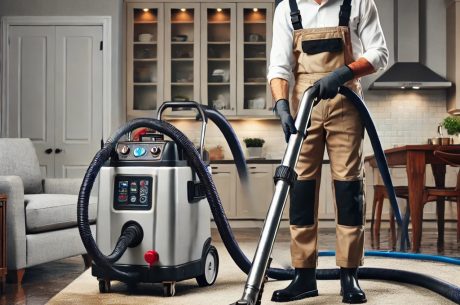Water floods can occur at any time, making them one of the greatest inconveniences. It is important to understand how to respond to avoid further harm and to have a proper plan for recovery. However, most homeowners make some mistakes after water damage, which makes the process of restoring their homes costly and time-consuming.
This article will help you understand these mistakes and how you can avoid them by explaining the importance of correct water damage restoration.
Mistakes to Avoid during Water Damage Restoration
Certain mistakes can be made during water damage restoration in your home, which can actually aggravate the situation and cost a lot of money. Below are the main blunders to avoid during water damage restoration to ensure a correct restoration.
- Failing to act quickly
A mistake that most homeowners will be guilty of is procrastination when it comes to water damage. This is why it is very important to rectify the situation with the least delay possible. It can get into walls, floors, and furniture, and this may lead to damage to structures and the formation of molds, which may start to develop within 24-48 hours. The longer water is left to stay, the worse the damage is, making the restoration process even harder and more costly. Such a progression’s fast pace means that it is necessary to begin the restoration process as soon as possible.
Prioritize safety first
When it comes to water damage, always seek safety first before you do anything else. Switch off the power supply in the affected regions to avoid electric shocks in case water has reached electrical sockets or appliances. When working with any form of water that may be contaminated, such as sewage, it is advisable to wear protective clothing, such as gloves, boots, and face masks.
- Not assessing the full extent of water damage
People are not always aware of the water damage, they only look at the most apparent signs. But, water can seep into the structure of your home, compromising walls, floor, insulations, and also the heating and air conditioning system. If the moisture is not detected it may cause more serious issues in the future like shifting of structures and mold formation. This is why many homeowners fail to evaluate all areas of water damage and, therefore, do not complete the restoration.
A thorough inspection is key.
However, if you want to ensure that you do not miss any latent damages, you should consider conducting an assessment of your property. Water must also be inspected at places which may have infiltrated and are not noticeable such as under floors, behind walls, or in the AC system. A proper inspection makes sure that all water is gotten rid of and no other problems are experienced later on.
- Skipping professional restoration services
There are some people who attempt to carry out the water damage restoration on their own, especially when the extent of damage appears to be small. Small amounts of water leakage or even spillage may not necessarily need the services of a professional. However, large areas of water damage do. Doing your own restoration increases the chances of the area not being dried properly, which leads to mold, rot and structural damage, which might not be noticeable initially.
Why DIY solutions often fall short
The majority of the homeowners do not own the required equipment for the extraction and drying of water. For instance, normal home-use fans cannot effectively dry walls, floors, or carpets that have been soaked, resulting in moisture. The moisture, if not detected, can result in mold formation which not only damages the structure of your home but also carries health risks. Industrial-grade equipment, including dehumidifiers, air movers, water extractors, etc, are used by professionals to ensure complete drying and dehumidification.
- Failing to document the damage for insurance
If water damage occurs, there are some initial things that the homeowners should do and one of them is to take pictures of the damage for the insurance company. Some of the common pitfalls include not taking enough photos or not documenting the extent of the damage or not keeping records of the communications with the insurance companies. If this is not done, you might end up paying for the damages yourself since your insurance claim could be denied or take longer to process.
Effective documentation tips
First, capture all the rooms and damaged belongings with the help of photo and video cameras from every side. Make sure you take a photograph or record the damage before any repair works are conducted. Furthermore, it is necessary to make a list of damaged personal belongings, including their cost and age. Save all receipts for any expense incurred in the water damage repair process, and keep records of all communications with the insurance company. Such detailed documentation will assist in fortifying your insurance claim and quickening the insurance claim process.
- Miscommunication with insurance companies
Claiming insurance is not easy when you don’t understand your policy, and it becomes even harder when you have to deal with the insurance company. This study reveals that homeowners misunderstand their coverage, resulting in underestimation of claims and out-of-pocket costs. Failure to communicate with your insurance provider will lead to slow processing of your claim or even rejection of the same.
Know your insurance policy.
One should be aware of what his/her insurance policy entitles him/her when it comes to water damage. Many policies deal with sudden and accidental situations like a burst pipe while leaving out slow progressive cases such as leakage or poor maintenance. It is always advisable to read through your policy and if need be, call your insurance company to clear the air on some of the issues that you did not understand. Contact them immediately if there is water damage since this will help the claim to be processed within the shortest time possible.
- Overlooking mold remediation
Flood-affected buildings are likely to develop mold formation, a major health risk if not well dealt with. Mold can develop within 24 to 48 hours after the building has been exposed to water, and the mold grows very fast. People who concentrate on drying the affected areas and fail to consider mold removal are exposing their homes and health to serious dangers. Mold is dangerous as it causes allergic reactions and breathing difficulties in people with compromised immune systems.
The need for professional Mold Remediation
Mold can grow in areas that are not easily visible, like behind the wall, under the carpet, or within the insulation. Therefore, it is important to incorporate mold removal into the water damage restoration process. Mold remediation services can find both easily noticeable and hard-to-see mold, eradicate it, and guarantee that your house is clear of mold spores.
- Ignoring preventive measures
However, after water damage, it is crucial not to neglect measures that can be taken to prevent such disasters in the future. Most homeowners do not follow the right measures to prevent future water damage to their homes, thus making them prone to the same losses.
Prevent future water damage.
To avoid such problems in the future, it is advisable to maintain plumbing, roofing and drainage systems frequently. The best way to reduce the risks is to book a plumbing check-up frequently to detect any signs of leaking or corroding pipes. Maintain cleanliness of both the gutters and downspouts to allow smooth water flow away from the house. Also, it is advisable to install a sump pump or a water leak detection system to let you know when the water is leaking so that you can make necessary arrangements before the water damages your property.
- Neglecting structural repairs
Flood water poses a threat to your home’s stability since it weakens the foundation. Water gradually damages different materials, including wood, drywall, and concrete, which could result in risks such as cracks in the foundation, walls falling, or sagging floors. Many homeowners tend to pay attention only to the aesthetic problems and neglect the underlying problems.
Addressing structural repairs promptly
When there is water damage, it is essential to have a contractor come in and inspect the structure for any signs of damage. Repairs should be done as soon as possible to avoid the situation getting out of hand and making your house insecure and weak. This is because if structural damage is not repaired at the right time, it becomes very expensive to repair in the future, and the safety of the house is at risk.
- Not maintaining plumbing systems
Leakage is a common reason for water damages and still, most people do not pay much attention to the plumbing system and its maintenance. If not detected on time, pipes may rust, burst or get blocked with debris hence causing a lot of water damage. Failing to service plumbing systems is one of the mistakes that are familiar to most people but which lead to damages that are not foreseen.
Regular plumbing inspections
You can prevent plumbing related water damage by making sure your home’s plumbing system is checked often. There are certain indications that should alert you to the possibility of leaks; they include; stains on the walls and floor, high water bill among others. Correct them as soon as possible and if some pipes are worn or rusty, it is better to replace them before they burst. Also, insulation of pipes can help in preventing the pipes from freezing and bursting especially during the winter seasons.
Conclusion
These are some of the most common mistakes that homeowners make and should be avoided to minimize the occurrence of water damages and to enhance the chances of a quick and efficient recovery when the damages have been done: Water damage restoration appears to be complicated but when you follow the right steps it will help in avoiding further damages and costly repairs. It is important that you act fast, take pictures of the damage and even call in experts to ensure that your home is safe and you can rest. If any doubt, it is always wise to seek the help of water damage restoration experts to ensure that your home is restored well and does not suffer future damage.




 PuroClean of Rochester Hills
PuroClean of Rochester Hills